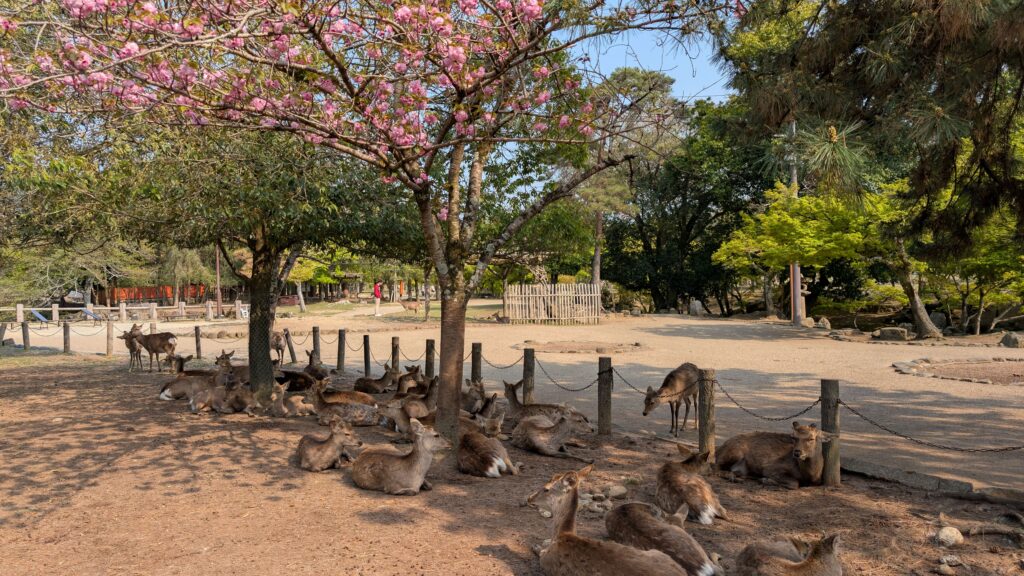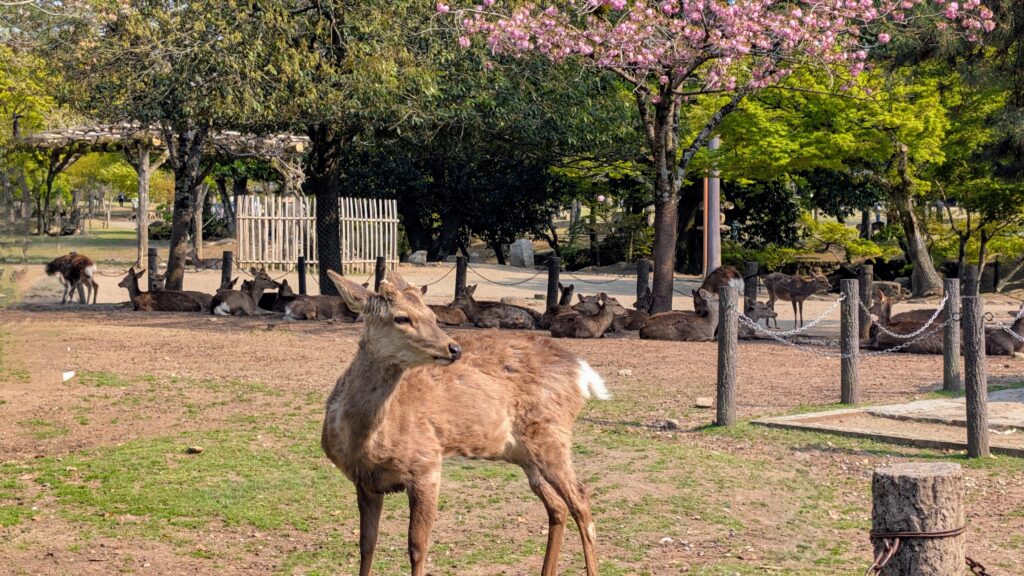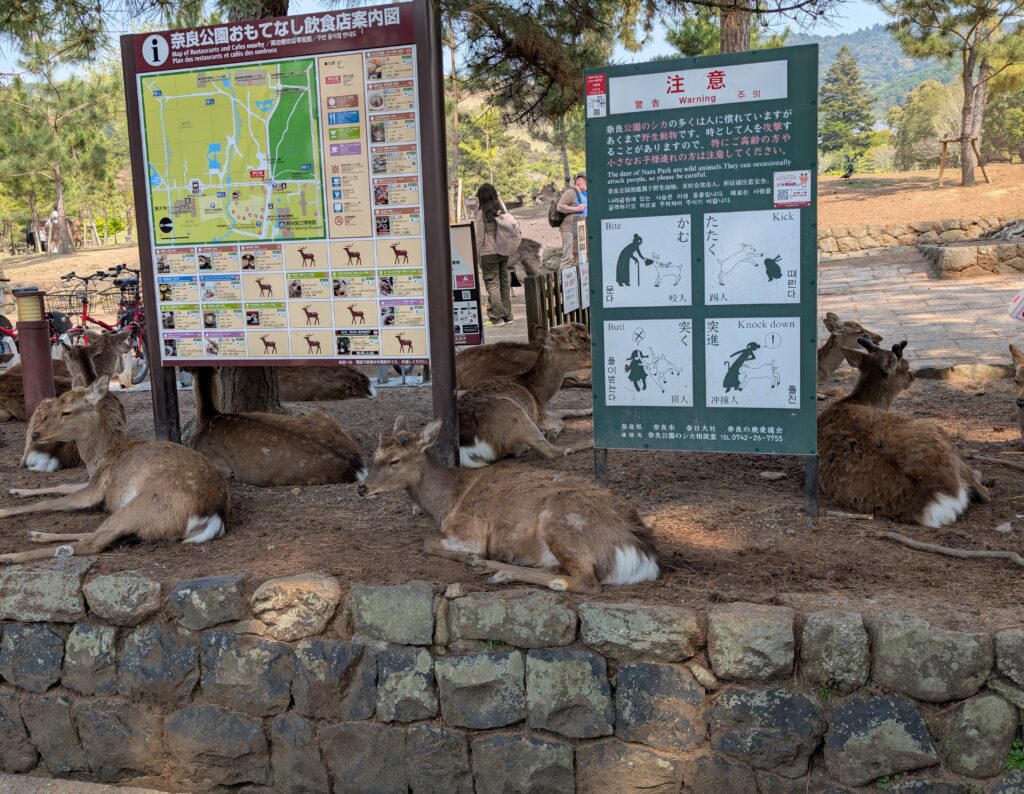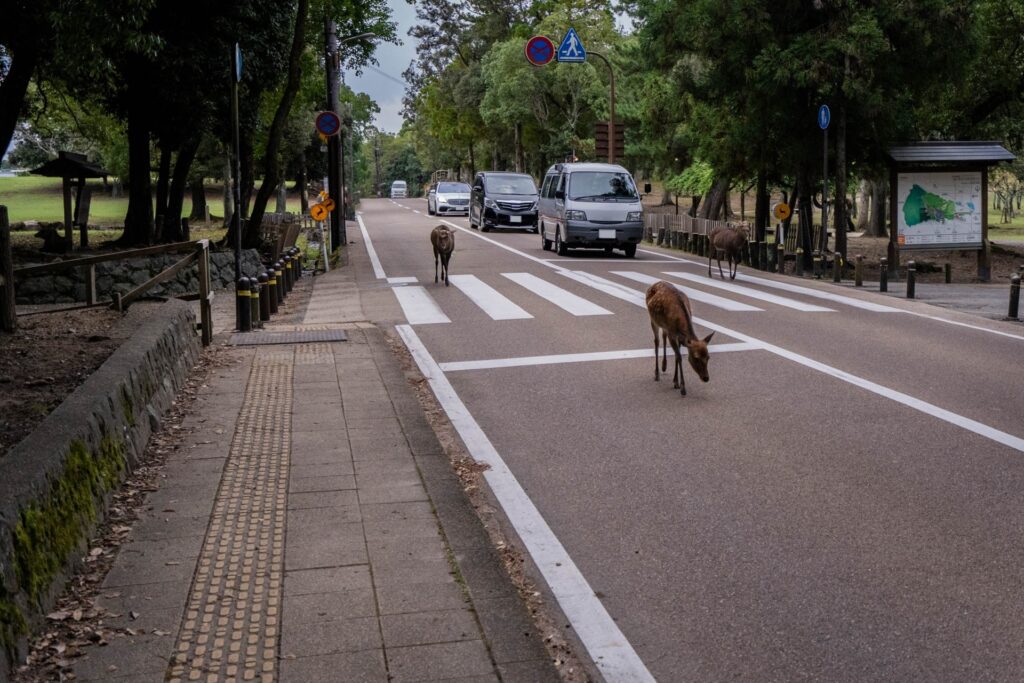1. The Deer in Nara Park
Tucked away in the ancient city of Nara, just a short train ride from Kyoto or Osaka, lies one of Japan’s most unique and magical destinations: Nara Park. This sprawling expanse of greenery, temples, and museums is home to more than just picturesque scenery—it is famously inhabited by hundreds of freely roaming deer, considered sacred and deeply intertwined with Japan’s history and cultural identity. For visitors, it’s a surreal experience: walking among these graceful creatures, bowing to them, and feeding them special crackers in a park that feels like a living museum.
But the story of Nara’s deer is far more than a tourist attraction—it is one of myth, tradition, literature, and daily rituals. Let’s explore the tale of Nara Park and the deer that call it home.
2. A Brief History of Nara Park
Nara Park (奈良公園, Nara Kōen) was established in 1880 and spans over 500 hectares in the centre of Nara City, in Nara Prefecture. But the land and its sacred significance go back much further, to the Nara Period (710–794) when Nara was Japan’s first permanent capital, known as Heijō-kyō.
The park encompasses some of Japan’s most revered cultural sites: Tōdai-ji Temple, home to the Great Buddha (Daibutsu); Kōfuku-ji Temple, and Kasuga Taisha Shrine, among others. These institutions were the heart of politics, religion, and art in ancient Japan. Nara Park grew around these heritage sites as a public space where nature and culture coalesced, and it has remained a tranquil escape for both locals and tourists for over a century.
3. When the Deer Started to Gather and Live in Nara Park
The origin of the deer in Nara Park is steeped in Shinto mythology. According to legend, when Kasuga Taisha Shrine was established in the 8th century, the deity Takemikazuchi-no-Mikoto (武甕槌命) travelled from Kashima Shrine in Ibaraki Prefecture to Nara, riding on the back of a white deer. From that time on, the deer were regarded as messengers of the gods, and killing one was a capital offence for centuries.
Because of this divine association, the deer were protected and allowed to roam freely around the sacred areas of Nara. Over time, they naturally settled in the park and surrounding temple grounds. Even after the separation of Shinto and Buddhism in the Meiji era and the subsequent loss of their divine status, the deer remained protected as a national natural treasure.
Today, more than 1,000 deer inhabit Nara Park, forming an extraordinary example of peaceful coexistence between wildlife and urban life.

4. The Deer in Japanese Literature and Pop Culture
Nara’s deer have not only walked the earth—they have walked through Japan’s cultural imagination, appearing in rakugo, literature, television, and even contemporary manga and anime.
In rakugo, a traditional form of comedy storytelling, deer appear as troublemakers at tofu shops (‘Shika-seidan’). A man selling tofu in Nara City accidentally killed a deer, which was a serious crime, and was brought before the magistrate, or machi-bugyosho. Impressed by his devotion to his parents and his honesty, the judge decided to let him go without penalty. The story emphasises the importance of deer in Nara as divine messengers. Literary figures such as Masaoka Shiki and Natsume Sōseki mention deer in their poetic or prose reflections on Nara. The deer are symbolic of both nature’s serenity and Japan’s historical continuity.
More recently, in the TV show ‘Shika Otoko Aoniyoshi,’ the deer appeared as beings that have protected humans for 1,800 years in Nara Park, and the deer ordered the main character, a high school teacher in Nara city, to help him to perform an important ritual that takes place once every 60 years, which saves Japan from a crisis.
Deer have appeared on NHK travel shows, in educational programs, and even in Ghibli movie settings, often as symbols of harmony between man and nature. Their bowing behaviour—something they learned from interacting with humans—has become iconic.
5. A Day in the Life of a Nara Deer: Diet and Habits
So, what does a typical day look like for a Nara deer?
The deer generally wake with the sun, gathering in open grassy areas or under the cherry trees in spring. During the day, they wander between temple grounds, shady forests, and tourist pathways. They’ve grown incredibly accustomed to people and often approach visitors, especially those holding shika senbei, the special deer crackers sold by vendors throughout the park.
These crackers are made of rice bran and flour and are safe for deer. While tourists often feed them, deer also graze on grass, fallen leaves, acorns, and native plants throughout the park.
Around midday, you’ll often find the deer resting in the shade or grooming each other—social behaviours that reinforce the tight-knit groups within the herd. In cooler seasons, they are more active, sometimes seen play-fighting or running through the fields.
By evening, most deer retreat to the quieter parts of the park, especially near the forests surrounding Kasuga-yama, where they sleep in peace under the stars.

6. Things Not to Do in Nara Park
While the deer are friendly and accustomed to people, it’s important to remember that they are still wild animals, not pets. Visitors must observe proper etiquette and safety precautions when interacting with them.
Here are a few don’ts:
- Do not feed them anything other than shika senbei. Human food, plastic, and paper can be harmful or fatal to them.
- Do not provoke or tease the deer. Pulling their antlers, riding them, or teasing them with food can lead to injuries. Some deer, especially males during mating season (autumn), can become aggressive.
- Do not litter. Even biodegradable items can harm the deer or disrupt the environment.
- Do not chase or startle them. Treat them with the respect you would afford a sacred symbol—or a fellow citizen.
- Many visitors try to tease the deer by delaying giving them crackers to make them bow repeatedly (most people think deer’s bowing is greeting or gratitude, but there is research that suggests the behaviour means just a request for food). It is essential to remember that the deer in Nara Park are wild animals, and they may become irritated and bite if teased excessively.
- Deer may perceive smaller people, especially children, as lower in rank and may act more aggressively toward them. Therefore, children should always be accompanied by an adult when feeding the deer.
The park has clear signs in multiple languages reminding visitors of proper behaviour, and it’s vital to follow them for both your safety and the welfare of the animals.

7.The Changing Behavior of Deer Across Seasons
The deer of Nara Park live in tune with the seasons, and their behavior changes subtly—and sometimes dramatically—throughout the year. Visitors who return in different seasons will notice these shifts.
In spring, especially during cherry blossom season, the deer are more visible and relaxed. The warmth and abundance of new grass make it a peaceful time. Young fawns are born between May and June, and you may spot protective mothers gently nudging their babies into the shade or away from curious visitors.
Summer brings heat and crowds, and the deer often seek out cooler spots under trees or temple eaves. They move more slowly, and their interactions with humans become more deliberate. Despite the humidity, they still gather for food and attention—especially in the early morning and late afternoon.
Autumn is perhaps the most dramatic season in terms of behavior. This is rutting season, and male deer, or stags, become visibly more active and territorial. Their once docile demeanor can shift—they may engage in sparring matches, and some show heightened aggression. Visitors are warned to be extra cautious during this time. The velvet on their antlers sheds, revealing sharp horns used in displays of strength and dominance.
Winter, though quieter in terms of tourism, offers a serene view of the park. The deer are more independent, moving in smaller groups and foraging more actively. Snow-dusted scenes of deer around temples like Tōdai-ji create postcard-perfect moments. Their thick winter coats give them a fluffy, majestic appearance, adding to their ethereal presence.
8. Rituals and Festivals Involving the Deer
The deep connection between Nara’s deer and Shinto tradition is not merely symbolic—it’s still enacted through seasonal rituals and festivals, many of which date back centuries.
The most famous is the Antler-Cutting Ceremony (Shika-no-Tsunokiri, 鹿の角切り), held every October in a roped-off enclosure near Kasuga Shrine. This tradition, which began in the 1600s, involves skilled handlers—often in traditional garb—capturing male deer and carefully cutting their antlers to prevent injuries during rutting season. While this may sound harsh, it’s done humanely and is crucial for safety—both for other deer and for park visitors.
The event is open to the public and resembles a choreographed dance, with the handlers using wooden poles, dexterity, and timing to corral the deer. Once caught, the antlers are sawed off swiftly and ceremoniously presented to the shrine as an offering to the gods.
Another spiritual observance is the Deer Blessing Ceremony, where Shinto priests offer thanks to the deer as sacred messengers. These moments connect the modern world with the traditions of animism and reverence for nature, central to early Japanese spirituality.
9. Co-existence of Locals and the Deer in Nara
Despite being wild and reproducing naturally, the deer population in Nara Park has steadily increased. However, during and after the Meiji Restoration, resistance to strong protective measures led to hunting for food during wartime, which caused the number of deer to drop drastically to just double digits. Since then, Nara City has actively worked to protect them.
The deer are now designated as a national natural treasure, and it is illegal to capture or harm them without permission within the park area, with penalties enforced. On the other hand, there have been frequent accidents involving deer and cars, as well as deliberate acts of cruelty after 2000, such as shooting with air guns or stabbing with knives.
Although deer are naturally cautious animals that avoid humans, Nara’s deer have become unafraid of people due to centuries of protection. As a result, they often wander onto roads, enter nearby homes or properties, and cause damage to local farms by eating vegetables and fruits, leading to frequent crop losses.
Nevertheless, deer’s “bowing” to request deer crackers (not express appreciation, but as a form of demanding food) is seen as charming and remains hugely popular among tourists.
At the same time, they are also an important tourism resource. Nara Park welcomes over 13 million visitors annually, many of whom come specifically to see and interact with the deer. In recent years, foreign tourists in particular have flocked to Nara, eager to take photos with the free-roaming deer in the city.
Naturally, deer in Nara bring in significant tourism revenue, but they also generate frustration from local farmers and concerns about tourist safety. Injuries to visitors could harm Nara’s public image. As a result, efforts are ongoing to balance deer protection with minimising damage and risk, soothing the concerns of affected citizens while preserving the deer as a cultural and economic symbol.
Even locals who experience minor property damage often accept it with a sense of religious tolerance, muttering complaints but ultimately saying, “They are divine deer.” This delicate coexistence is maintained through dedicated effort on both sides.

10. Environmental Conservation Efforts and Challenges
Protecting Nara’s deer today requires careful environmental management, especially as tourism grows and urban boundaries press inward.
The Nara Deer Preservation Foundation plays a critical role. They conduct regular health checks, provide veterinary care, manage births, and monitor deer population levels. Deer found ill, injured, or orphaned are brought to Rokuen, a small medical centre and shelter in the park.
However, conservation comes with challenges:
- Overfeeding with senbei can lead to malnutrition, as deer may neglect natural foraging.
- Littering, particularly plastic and paper bags, poses a deadly threat. There have been cases of deer dying from ingesting trash left by careless visitors.
- Traffic and the increasing number of vehicles in and around the park lead to occasional deer fatalities. Local authorities have installed deer crossing signs, speed bumps, and awareness campaigns to mitigate this.
- Climate change is also affecting the ecology of the park—altering vegetation patterns and the availability of food in different seasons.
The park relies on both scientific care and public cooperation to maintain a healthy balance. Eco-volunteer programs, educational signage, and community outreach efforts all aim to ensure that future generations will still be able to walk among Nara’s deer and feel the timeless wonder they bring.
11. The Deer in Nara Park: More Than a Symbol -A Living Heritage
Nara Park is not just a scenic destination—it’s a living, breathing example of Japan’s reverence for nature, tradition, and harmony. The deer, with their quiet gaze and gentle bows, remind us of a time when humans lived more closely with the natural world, when spirituality was found in the rustle of leaves or the gaze of an animal.
A visit to Nara Park is an unforgettable experience—not only for the temples and the cherry blossoms but for the moments of quiet connection you may feel with one of its many four-legged residents.
So, next time you find yourself in Japan, make the journey to Nara. Bring your curiosity, a pack of deer crackers, and an open heart. The deer will be waiting.
